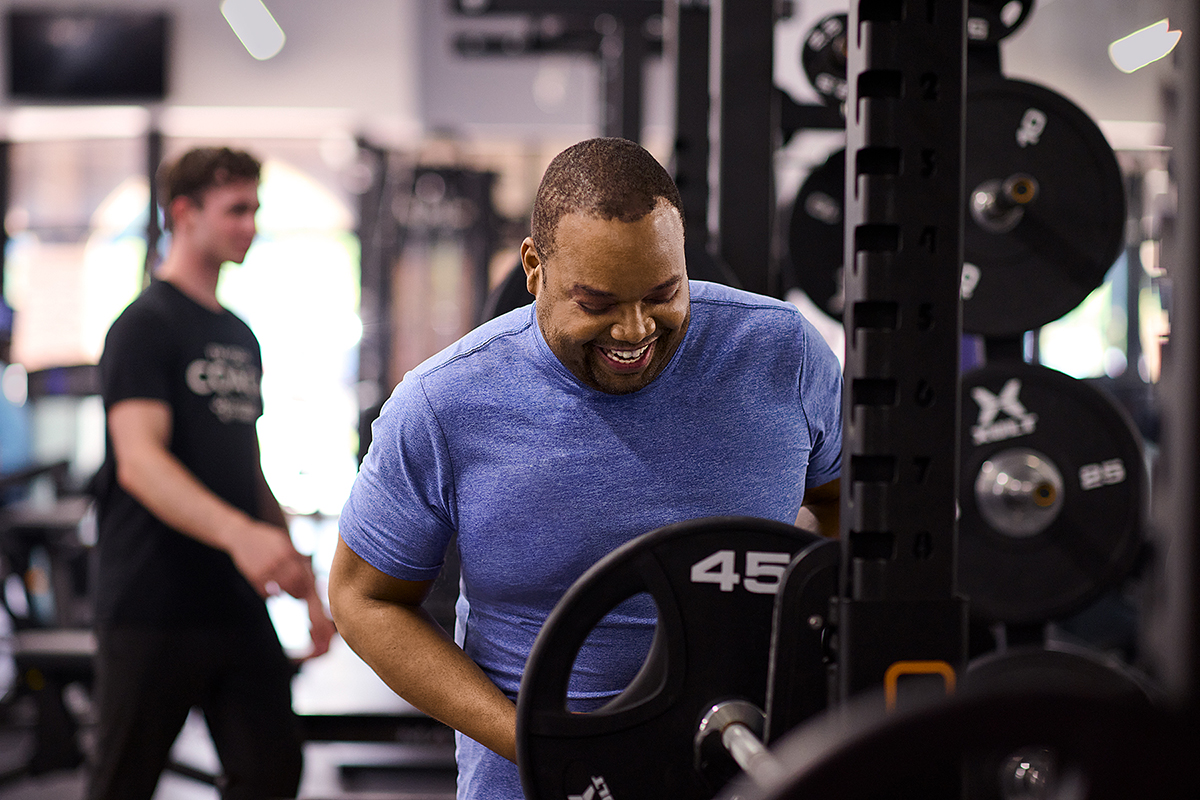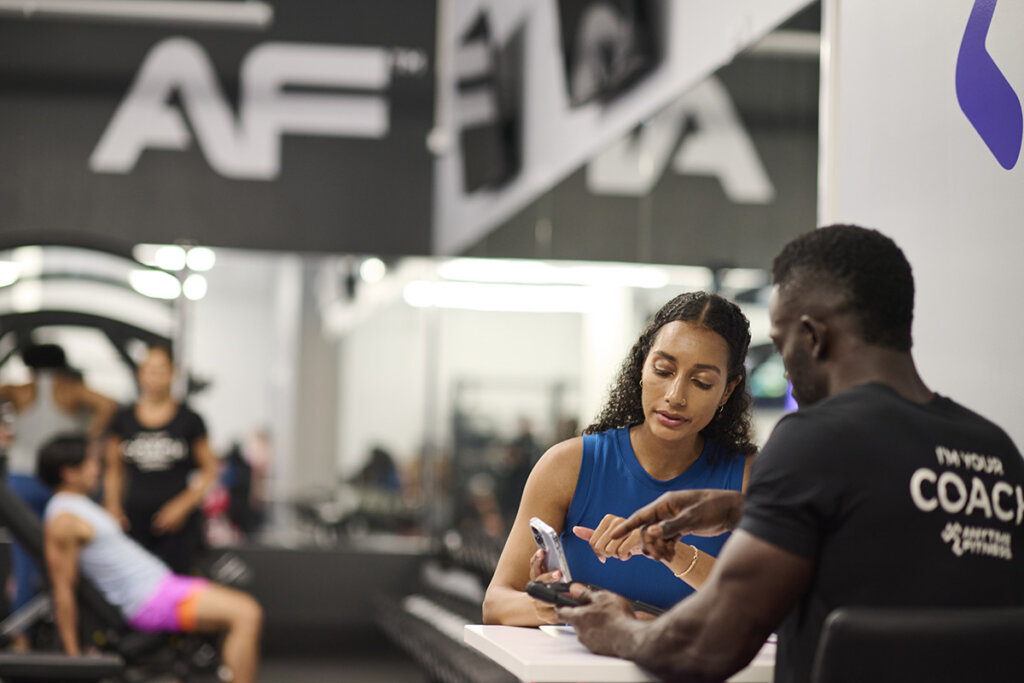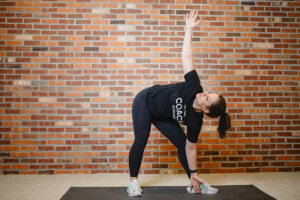Feeling motivated to exercise, getting in a full workout routine and seeing results all have one thing in common: a solid workout plan. Whether you’re brand new to exercising or have been doing it for years, laying this foundation can be a challenge.
Designed to simplify your fitness experience — in and out of the gym — the Anytime Fitness App is here to help you figure out how to create a workout plan. The app takes your activity preferences, goals, exercise routine timeframe, and much more into account. Think of it as your very own workout planner.
Ready to build your own workout schedule? In this blog, we’ll cover:
- How to build a workout with the Anytime Fitness App
- How to design a realistic workout schedule
- How long your workout plan should be
- Tips for listening to your body to choose reps and sets
- Why rest is essential for your health and long-term fitness
How to create your own gym workout plan in the Anytime Fitness App
The Anytime Fitness App not only helps you determine how to create a workout plan, it also makes it unique to you! It helps you create a customized, action-based guide that matches your fitness goals, current exercise habits, prior experience with working out, and workout location preferences (in the gym, at home, or both).
Getting started
When you download the Anytime Fitness App and create your profile, you’ll answer a set of questions that allows the app to create a customized workout plan for you.
These questions include things like:
- Your personal stats (height, weight, etc.)
- Your fitness history (current workout intensity, experience with lifting weights)
- Your health goals (how often you want to work out, your fitness goals, how much time you can dedicate to each workout, and more)
How to access your Training Plan
Once you’ve answered these questions to set up your profile, you’ll be given a Training Plan that includes the desired number of workouts per week, whether that includes strength training, upper body and lower body workouts, cardio, or other Anytime Fitness services and training types.
Designed to help you reach your goals, your Training Plan is easy to access. That means every single time you head to the gym, you’ll have a built-in workout planner in your pocket. Just open the Anytime Fitness App, and you’ll find it right on the home page! You can make changes to the workouts and even add a customized workout of your own — but the foundation will be laid out for you in your Training Plan, so you don’t have to worry about calculating reps, sets, intervals, or other factors.
Example Training Plan

How to create a workout plan that fits in with your life
You don’t need to spend hours in the gym strength training to stay healthy and reach your fitness goals. While that scenario may be what’s best for you, there are countless ways to practice fitness and there is no one-size-fits-all formula. Using basic guidelines about things like recommended cardio and exercise time, you can craft a plan that fits your capabilities and interests.
The U.S. Department of Health and Human Services also develops and routinely publishes evidence-based recommendations for physical activity for all adults. We recommend using these as a starting point. The updated guidelines are found in the Physical Activity Guidelines (PAG) and are meant to help improve health outcomes.
In the most recent version, it is recommended that adults should do one of the following:
- At least 150 minutes to 300 minutes a week of moderate-intensity activity (Think cardio)
- 75 minutes to 150 minutes a week of vigorous-intensity aerobic physical activity (Think challenging upper-body or lower-body workouts)
- An equivalent combination of moderate- and vigorous-intensity aerobic activity
- In addition, adults should also do muscle-strengthening activities on two or more days a week
Reflect on what feels right for your existing routine and fitness level
The best workout schedule for you is one that you can realistically stick to! Adherence to your fitness plan is a key factor in achieving the results you want, so it is important to set realistic goals and avoid overcommitting. If you find that you are showing up to the gym regularly on your planned workout days, but that you’re feeling room for growth, go ahead and add an additional workout day each week to your schedule.
As far as what muscles you’re working on during each workout, there are a variety of ways to split your workouts up into different focus areas. Whether you’re looking for workout splits to support muscle gain or workout splits for weight loss, we have tools to support you.

3 things to keep in mind when designing your workout routine
- Start by looking at your calendar. Before getting started, look at your schedule and see where you can set time aside for your workout. Choose realistic days and times you can commit to, and use that information when setting up your workout plan in the Anytime Fitness App.
- Explore your workout plan options. Setting up a motivating workout plan is about finding a balance between exercises you already enjoy and new ones to try out and get inspired by. Check out all your options within the app and try out a few different formats to see what helps you get energized.
- Use the Anytime Fitness App to stay on track. The app can track progress, send you reminders, and do so much more to keep you engaged on your fitness journey. Keep it front and center on your phone’s home screen as a daily reminder to keep going!
Time and frequency: How to structure a workout
The ideal duration of your workout depends on a few factors, including the amount of time you have available, your muscular and cardiovascular endurance, the number of reps and amount of rest time between sets that you prefer, and the number of workouts you are able to do per week.
Short on time? No worries — you have flexibility to do a workout that works for you. To reach the recommended 150 minutes of activity per week, you could choose any one of the following plans:
- Five 30-minute workouts
- Four 40-minute workouts
- Three 50-minute workouts
Intensity and duration are a balancing act — here’s what to know
In general, the higher the intensity of the exercises, the shorter the workout duration will be. If you’re doing lower- to moderate-intensity exercises, you’ll probably be able to endure them for a longer time. This will vary from person to person, but may be in the range of 45–60 minutes. If your workout includes high-intensity training or vigorous work such as treadmill sprints or circuits with little rest time, a shorter duration such as 25–30 minutes is ideal to avoid overtraining. Overtraining can happen with strength training, cardio, and other types of exercise, so it’s always important to listen to your body and know the signs, which can include chronic exhaustion and poor digestion.
How to exercise certain muscle groups together
There are many ways to split your workouts across your body’s muscle groups. A popular method for dividing up your muscle groups into separate workouts is known as PPL (push, pull, legs). In this format, you work your body is “pulling” muscles (back and biceps) on a different day than you work the “pushing” muscles (chest, shoulders, and triceps). Legs are done on an entirely different day, resulting in a three-days-per-week split.
Another option is to perform a full-body workout each time you exercise. In this case, it’s important to focus on different phases of training instead, so that each week you can address stability, strength, and power. This is a format called undulating periodization. This approach means that you’re alternating the focus of your workout throughout the same week, increasing your body’s physical performance over time.

Plan workout splits to your advantage
The best workout split is one that challenges your body, addresses a wide variety of muscle groups and can be practiced consistently. Looking for inspiration? Here’s our recommended breakdown, with guidelines to get started below:
- Workout Split Day 1: Chest — Exercises: Bench press, incline bench press, flat or decline fly, low pulley crossovers, high pulley crossovers
- Workout Split Day 2: Back and Abs — Exercises: Deadlifts, pulldowns, seated, incline and inverted rows; knee raises, bird dogs, oblique pushups, planks, farmer’s carries
- Workout Split Day 3: Shoulders and Traps — Exercises: Overhead press, upright rows, lateral raises, rear delt fly, front raises; shrugs, reverse shrugs, straight arm pushdowns
- Workout Split Day 4: Arms — Exercises: Barbell curls, preacher curls, close grip bench press, tricep pushdowns
- Workout Split Day 5: Legs and Calves — Exercises: Squats, Romanian deadlifts, leg presses; standing calf raises, seated calf raises, single-leg weighted calf raises
Ready to take a break? Here’s why rest days matter
When thinking about how to build a workout you can enjoy and stick to, don’t forget one key piece: rest. This is just as important as exercise when it comes to crafting the perfect workout plan. While pushing yourself with a challenging workout split or high reps and sets can help you achieve your goals in the gym, occasional (and sometimes frequent) rest is equally important. Rest days are essential for allowing your body to recover and rebuild, and also help to prevent overtraining and injury.
Think of it this way: When you’re doing a cardio workout, the warm-up and cooldown allow your body to acclimate to its peak performance. Similarly, rest days allow your body (and mind) to recover from the hard work that comes with a workout routine. This applies to strength training, cardio fitness classes, and any type of gym exercise — everyone needs an off day from time to time!
Use these tips as guidelines:
- Give your muscle groups at least 24–48 hours after an intense, focused workout session before targeting those muscle groups again.
- Make sure to alternate between push, pull, and leg workouts so you’re not repeating a workout without at least a day or two of rest and recovery in between similar workouts. For example, avoid doing two leg workouts on back-to-back days.
- Feel free to take more rest days than usual if you’re feeling sick, or if you find that you do not have enough energy at the start of your next workout to perform at the level that you know you can.
- Listen to your body and remember that recovery is just as important as training and nutrition.
Final reminders for your exercise routine
Now that you know how to create a workout plan, you’re ready to put it into practice! The Anytime Fitness App provides step-by-step guidance for workouts that match your activity preferences and align with your goals. Workouts will account for things like how much time you have, and can even show you exactly how many reps and sets to do, making it easy to add into your workout routine and follow along… starting today!
Personalized support is what we do! Take your fitness journey to the next level with a free plan that’s uniquely yours when you become a member of Anytime Fitness.



